Burning Opportunities
By Brett Martin
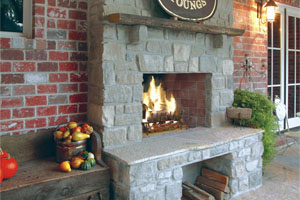
While fireplaces have always been a mainstay in residential buildings, these optional systems are becoming highly prized for increasing resell and perceived value for many types of real estate and building projects, from single-family homes to outdoor retail plazas. At the same time, fireplaces are becoming more efficient and offering better air quality.
"All of the new fireplaces burn more efficiently and cleaner," says Deidra Darsa, public relations and media relations manager for the Hearth, Patio and Barbecue Association (HPBA) in Arlington, Va. Fuel options for the fireplaces include wood, pellets, electricity and, the most popular, gas.
Tom Stroud, senior manager of codes and standards for HPBA, says the industry is creating standards for cleaner burning masonry fireplaces.
"The goal is to improve the outdoor air quality," Stroud says. "By doing that, more often than not, you're improving indoor air quality."
Part of maintaining optimum air quality is having the proper size, shape and height for the chimney. "The biggest thing mason contractors need to make sure of is that the chimney is built tall enough to draw properly," Darsa says. "Making sure of the height requirement on the roof and how far to stay from the neighbor's house are important."
Darsa says most gas fireplaces now have a direct vent, rather than a full chimney going through the roof. The fireplaces vent outdoors through a wall, which reduces installation costs.
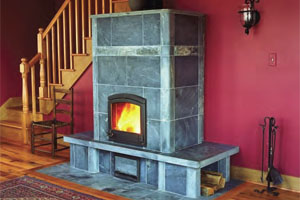
"Masonry heaters burn a brilliant, hot fire in the firebox, while hot gases circulate through channels in the masonry mass, storing heat," says Dann Carnes, owner of Fireplace Editions in Chapel Hill, N.C. "Warmth radiates throughout your home long after the fire is out. Healthful and clean, masonry heaters are regarded as the ultimate in efficient and environmentally sound wood burning."
Carnes says after burning a one- to two-hour fire, the homeowner feels warmth for 12 to 24 hours.
"You want a very intense blast for one to two hours," he says. "After that, the fire dies out. While you're burning it, it's like an inferno: very mesmerizing flames.
"The heaters are great for large, open areas with tall ceilings," Carnes continues. "Unlike forced air convection heat that rises quickly to the ceiling, radiant heat warms the floors and the people who occupy the lower portion of rooms."
Jerry Frisch, president of Lopez Quarries Masonry Heaters Firecrest Fireplace Corp. in Seattle, says homeowners appreciate the functionality of the heaters.
"People see that these are simple, very functional, and easy to use," says Frisch, who has built nearly 500 masonry heaters during the last 20 years. "These heaters are very low maintenance. A traditional fireplace is like feeding peanuts to an elephant: You have to keep feeding logs and have to keep tending the fire. A masonry heater doesn't work that way, and people like that."
The heaters typically cost between $13,000 and $17,000. Most of Frisch's clients are well educated, want environmentally friendly products, and are building $300,000 to $500,000 homes. Some of his clients in the Northwest heat their entire 2,000-square-foot homes the entire winter with no other heat source.
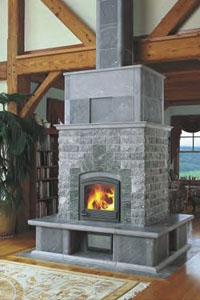
Carnes agrees, adding that masonry heaters are often used in timber framed homes, log cabin homes, or contemporary homes with open floor plans. "They can be used in a very wide variety of homes," he says. "The key thing is that open designs are most suitable."
Carnes says that because the heaters burn hot and fast, the fire is cleaner, while the radiant warmth produced throughout the day has a soothing effect.
"The typical warmth that you get is a gentle, radiant warmth that penetrates deep into the muscles," he says. "It doesn't dry out your skin the way forced air heat does. We're not going through ducts with our heat, so we're not relying on blowers or stirring up dust that you breathe. That makes it healthier. People are concerned about indoor air quality, and masonry heaters address that concern."
Any type of wood can be used for the fire, as long as it's dry. Carnes even burns wooden pallets so they can be put to good use rather than dumped in landfills.
"There is not just one, but many reasons to have a masonry heater, he says. "When people look at it they say, 'This really makes a lot of sense.' The U.S. Green Building Council's LEED (Leadership in Energy and Environmental Design) program, gives points for high efficiency fireplaces, including masonry heaters. This is a growing movement to promote healthier, higher efficiency, and sustainable home building."
Carnes encourages masons who are interested in building the heaters to join the Masonry Heater Association, which offers conferences and training sessions for building masonry heaters.
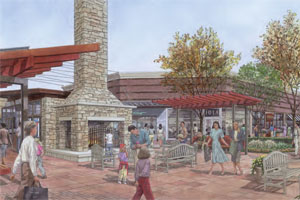
"The fireplace is going to be the heart of the plaza," says Steve Henri, director of planning and design for Bloomfield Hills, Mich.-based The Taubman Co., which built the mall. "The fireplace is a place for gathering. It really adds a legitimate character to the area."
Henri said the biggest challenge was finding ceramic logs large enough to fit the eight- X six-foot opening of the 12-foot-wide cultivated stone fireplace. The logs were eventually custom made. The fireplace took about six months to construct, while the plaza took more than two years of planning and construction.
"The challenge was designing and thinking everything through, but it really went smoothly," Henri says.
HPBA's Darsa says outdoor rooms with fireplaces are becoming more popular. "With an outdoor fireplace, you can extend the outdoor season, she says. "You can stay outdoors and enjoy the season longer. A fireplace tends to be the focal point of an indoor room, and the same is true outdoors. A fireplace draws people in, so they want to sit down and be next to it."
That's the premise behind the fireplace at the Mall at Partridge Creek. Benches and rocking chairs near the fireplace allow shoppers to relax near the gas fire, which burn year round to light up the night, Henri says.
"The whole concept of an open air mall in Michigan is to celebrate the seasons of Michigan," he continues. "I think people in Michigan want to be outdoors."
Plaza sidewalks include a heating system under the pavers to melt the snow, eliminating the need for salt, Henri adds.
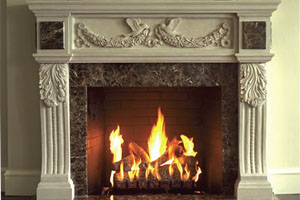
"There has been an interest in mantels for many hundreds of years," Arnold says. "It's typical for them to go in the most important room in the house."
Arnold, who has been carving since 1985, after studying in Italy and working on the National Cathedral in Washington, spends anywhere from a few days to more than one year carving each mantel. Prices vary greatly, generally starting at $5,000 to $6,000.
"If you look at what people are spending money on nowadays, things that will go out of fashion in a year, the price of a hand-carved fireplace is not that out-of-line at all," Arnold says, adding that hand-carved mantels are not so much a trend as traditional products. "It's coming back to what has traditionally been important. Rather than a trend, it's a return to long-standing taste and values."
Olivier Dumont, a French-trained artist and co-owner of Atelier Jouvence Custom Stone Works in Chicago, says he's experiencing a growing demand for his hand-carved limestone fireplace mantels.
"There is an increasing demand for it, as people see it as an option," Dumont says. "They're really quite functional works of art."
Some mantel designs have a lot of fancy, ornate detail, but the current trend is toward straight, clean lines. "It may have to do with people wanting the fireplace to look beautiful, not to be the focal point, but to look beautiful with everything else in the room," he says.
Having a foreign-trained carver produce mantels in the Unites States allows customers to get a European designed piece without having to hassle with language barriers and shipping overseas.
"People think they need to buy from a company in Europe if they want a French mantel," Dumont says. "But they're made here from a French carver trained in France who knows the style. All of our carving is done in the United States. You don't need to deal with communication problems overseas."
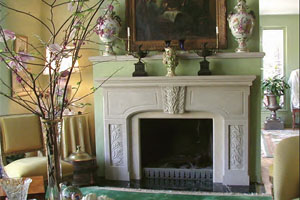
"Fireplaces can be a 3-D jigsaw puzzle," Arnold says. "People have to think in 3-D to align everything, because it is cut very accurately. If something doesn't line up, don't force it. Call the carver."
Dumont sells about 70 percent of his mantels in the Chicago area and works with local masons who are familiar with the installation. "You need someone who's careful and meticulous," he says. "A good stone mason shouldn't have any trouble with installation. It is a standard masonry installation."
The same goes for fireplace mantel replicas that are made from molds, says Jerry Campbell, sales manager for Old World Stoneworks in Dallas. "There's nothing unique about the installation," he says.
Campbell adds that although the cast stone requires just one to two days for production, it needs another 21 days to cure. The mantels then become two- to three-times stronger than concrete.
"Some of these pieces are huge," he says. "They're proportioned to fit the size of the room. [The mantels] have a top-class look. They're the focal point of the whole house, and people gather around them."
About the Author
Brett Martin is a freelance writer located in Shakopee, Minn. with several years of construction and writing experience.


















